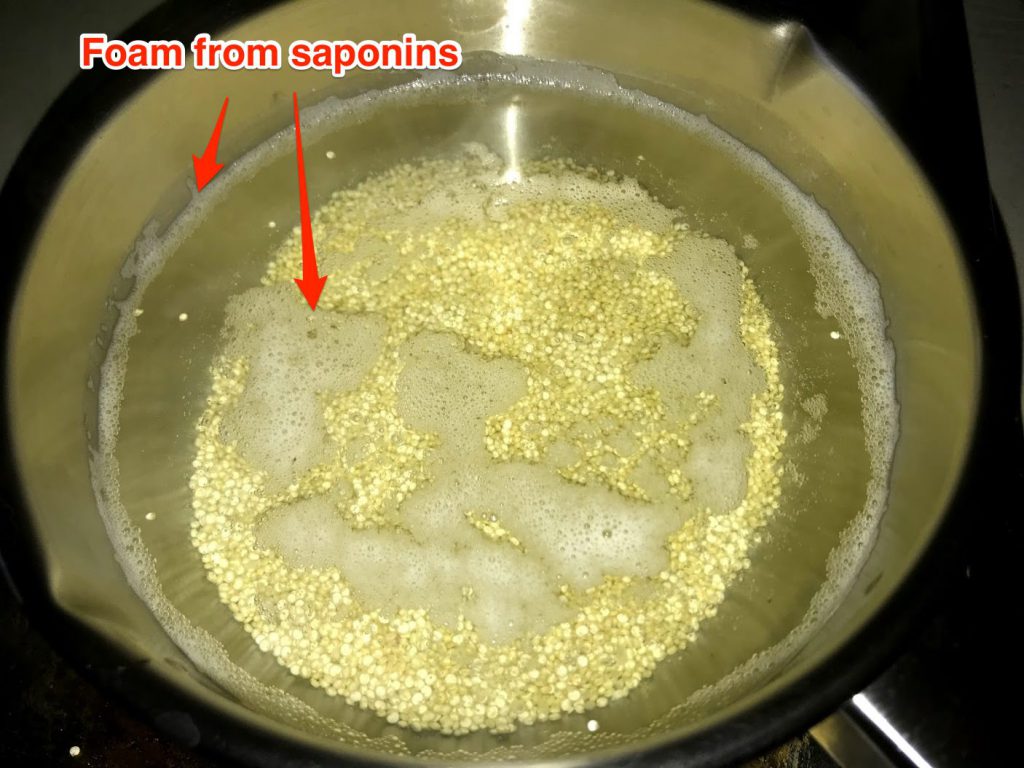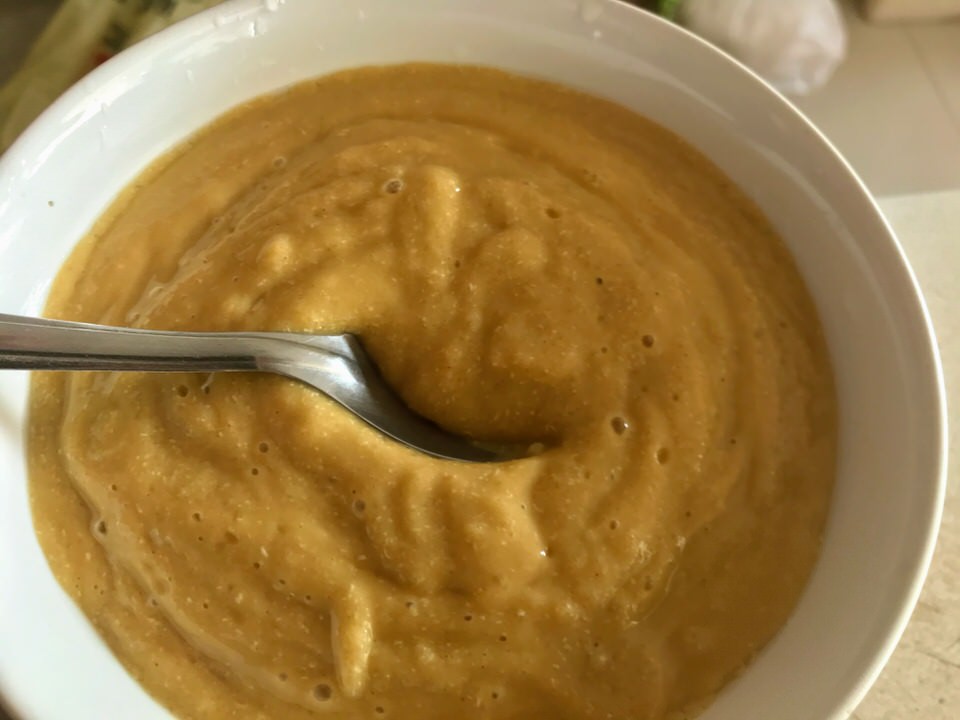I put Quinoa in a blender and pulverized it. Then added 20g into my shake. Tasted fucking delicious. Next time I’ll try 50g.
Really? Quinoa for musclebuilding? You sure?
Based on what I’ve learned when looking into the matter, I do think that quinoa is a great food for anyone who wants to take in more high-quality proteins for muscle growth. Quinoa is a complete protein (not like many other plant-based proteins), and has many other benefits.
But obviously, I could be wrong. So let’s look at some other people who believe that quinoa for muscle growth is legit:
Jeff Cavalier from Athlean X says in this video that quinoa can be a great source of protein for bodybuilders. (Other foods he mentions? Chickpeas, hummus, pea-protein supplements
Quinoa is a carb, not a protein
Now as much as I love to throw love at quinoa, it’s important to be clear that quinoa is primarily carbohydrates, not proteins. However, it’s high-quality carbs, made up mostly of starch and fibers.
Glycemic index of quionoa: 38
GI of pasta*: 50
GI of white rice: 70
GI of bread*: 75
GI of french fries: 78
* there are different kinds of pasta and different kinds of breads, but on average, the most common kinds of pasta and bread have these GI values.
This means that eating quinoa won’t spike your blood sugar nearly as much as rice, pasta, or bread. The higher the glycemic index of a food, the more it will also cause your body to create and store body fat. So you really want to chose low-GI foods as much as possible.
Quinoa nutrition
When you look for nutritional value of quinoa, you’ll come across all kinds of numbers in various articles, with the range of protein content, fiber content, etc sometimes varying widely. Many of these articles don’t provide any source, and I suppose oftentimes it’s some author who “read it one the internet”.
I decided to use the USDA National Nutrient Database for Standard Reference as my source. And when you look up uncooked quinoa, here’s what you’ll get:
Here’s a chart in case you want to copy-paste the data:
| Nutrient | Unit | per 100 g | per 1 cup = 170.0g |
| Proximates | |||
| Water | g | 13.28 | 22.58 |
| Energy | kcal | 368 | 626 |
| Protein | g | 14.12 | 24 |
| Total lipid (fat) | g | 6.07 | 10.32 |
| Carbohydrate, by difference | g | 64.16 | 109.07 |
| Fiber, total dietary | g | 7 | 11.9 |
| Minerals | |||
| Calcium, Ca | mg | 47 | 80 |
| Iron, Fe | mg | 4.57 | 7.77 |
| Magnesium, Mg | mg | 197 | 335 |
| Phosphorus, P | mg | 457 | 777 |
| Potassium, K | mg | 563 | 957 |
| Sodium, Na | mg | 5 | 8 |
| Zinc, Zn | mg | 3.1 | 5.27 |
| Vitamins | |||
| Thiamin | mg | 0.36 | 0.612 |
| Riboflavin | mg | 0.318 | 0.541 |
| Niacin | mg | 1.52 | 2.584 |
| Vitamin B-6 | mg | 0.487 | 0.828 |
| Folate, DFE | µg | 184 | 313 |
| Vitamin B-12 | µg | 0 | 0 |
| Vitamin A, RAE | µg | 1 | 2 |
| Vitamin A, IU | IU | 14 | 24 |
| Vitamin E (alpha-tocopherol) | mg | 2.44 | 4.15 |
| Vitamin D (D2 + D3) | µg | 0 | 0 |
| Vitamin D | IU | 0 | 0 |
| Vitamin K (phylloquinone) | µg | 0 | 0 |
| Lipids | |||
| Fatty acids, total saturated | g | 0.706 | 1.2 |
| Fatty acids, total monounsaturated | g | 1.613 | 2.742 |
| Fatty acids, total polyunsaturated | g | 3.292 | 5.596 |
| Cholesterol | mg | 0 | 0 |
So there you have it. 100g of uncooked quinoa contain 14g of protein and 7g of fiber, according to the USDA.
Lysine
Lysine is a amino acid that your body needs, but can’t produce itself. And quinoa has plenty of it. Skeletal muscle has plenty of lysine, where it helps with the maintenance and building of skeletal muscle tissue. (Other foods that contain plenty of lysine? Beef, fish, beans, chicken, soy, dairy.)
When you exercise your muscles, what happens is that your muscle proteins break down. Lysine is a substance that helps to rebuild muscle tissue (and increases the speed of recovery after a workout).
How much lysine should you consume per day? On average 0.85g. People who exercise should take in more than that, ideally somewhere between 1g to 3g daily.
Quinoa and gas
When I started eating quinoa, I also started passing gas… a lot of it. And that’s not unusual. Quinoa contains plenty of fiber and saponins. Now the good news is: There is an easy fix for this!
Reduce the amount of quinoa you consume, so it’s easier for your body to adopt to it. Then you can gradually increase your quinoa “dose”, and your body will be able to handle it just fine, without causing gas.
Why does quinoa cause gas?
There are two main reasons:
- Fiber
- Saponins
Let’s take a closer look at both of these:
Fiber
Quinoa contains almost twice as much fiber as other grains. (Yes, if you object to calling it a grain because it’s actually a seed, that’s fine. But I figure since most of us eat it just as we eat grains, it’s a fair comparison.)
[] tk find image of fiber
Make sure to drink plenty of water and non-caffeinated drinks. If your body isn’t used to you consuming a lot of fiber, it will take some time for your body to adapt to the increased fiber intake. But that’s a good thing. Fiber is good for you.
Saponins
Quinoa also contains saponins—which naturally defends quinoa against insects and birds. So that’s good, because there’s no chemical pesticides required.
Are saponins harmful?
Some research indicates that quinoa saponins might be harmful.
Many landraces of quinoa contain saponin in the seedcoat. Saponins function as “antinutrients” and are frequently associated with plant lipids. They are not normally absorbed from the gut and have been shown to induce small intestinal damage or reduce intestinal absorption of nutrients (Jenkins 1988).
[Source]
However, low doses of saponin are probably safe, and might even have health benefits that outweigh any negative effects saponins might have on you.
Even more: it’s very easy to remove saponins from quinoa: Just rinse the quinoa in water. The saponins are contained in the outer seedcoat, so all it takes is a simple rinse with cold water to remove the saponins.
When you cook your quinoa, and it forms plenty of this foam, then that means you haven’t washed your quinoa properly, because it’s the saponins that cause the foam (which is also why they’re called saponins—because they create this soap-like foam): Just to give you an idea: this is from not pre-washed quinoa which I gave a very quick rinse. As you can see, there’s still a good amount of foam building on top of this.
Just to give you an idea: this is from not pre-washed quinoa which I gave a very quick rinse. As you can see, there’s still a good amount of foam building on top of this.
Quick recap:
If you experience gas after eating quinoa, here’s two things to do:
- Lower the amount of quinoa you eat, so your body can adapt to the higher fiber intake. Drink plenty of water. Gradually increase the amount of quinoa you eat.
- Rinse the uncooked quinoa seeds first. And ideally buy pre-washed quinoa (where the saponins are usually already removed).
What does quinoa taste like?
It honestly doesn’t have that much of a strong flavor. Which I like, because that means you can mix it with a bunch of different foods, and it rarely clashes with anything you want to eat it with. Works fine with sweet or savory flavors.
Some people describe the taste of quinoa as “brown rice crossed with oatmeal”. I’m not sure if I agree with that description, but it gives you a basic sense of the flavor profile.
Bitter? Tastes like dirt?
Now if you ever ate quinoa and it “tastes like dirt”, then know that there’s an easy remedy for that. Simply rinse the quinoa more thoroughly. What causes the bitter “dirt” taste is just the saponins—the quinoas own natural pesticide covering the outside husk. It literally is supposed to taste bad so that insects, birds (or humans) don’t eat it. If you wash your quinoa thoroughly to remove the saponins, it won’t taste like dirt, nor will it taste bitter.
How to prepare quinoa
Honestly, I’m still figuring out the best way to prepare quinoa, and I’ll keep trying out different things and update this post.
Initially, I just took about 50g of uncooked quinoa, put it in a blender to turn it into a powder, and put that into my shake. However, that really caused a lot of gas.
So now I’m cooking the quinoa and that’s easier to digest. Here’s what quinoa looks like cooked:
I cook it and put it into my shakes. It’s quite a nice thickener, so it turns a liquid smoothy into something more solid—almost a pudding if you add a lot of it to your smoothie.
Here’s the result of taking 50g of quinoa, cooking it, and throwing that into a blender together with a mango, 200ml of pistachio milk, and some cinnamon:
It’s got a pretty smooth, somewhat bland taste, which is nice for a nourishing breakfast that’s easy to digest, not heavy in your stomach, and yet full of nutrients and energy.
Quinoa with black beans
Another simple way to prepare quinoa is to just mix it with some black beans from the can. Cook the quinoa. Open a can of black beans. Mix ’em into the cooked quinoa. Add some salt and a bit of butter. Get cheap your superfood protein meal.
 Not claiming that this is gourmet food. Not a culinary experience that’ll blow you away. But it’s nourishing, quick, simple, healthy and cheap.
Not claiming that this is gourmet food. Not a culinary experience that’ll blow you away. But it’s nourishing, quick, simple, healthy and cheap.
Quinoa with lentils and spinach
Again, a super-simple and cheap way to prepare a quick quinoa meal:
- Cook quinoa and put it in a bowl
- Open a can of lentils and heat them up in a pot
- Take some frozen spinach and boil it until it’s hot
- Mix all of that in a bowl. Add salt. Eat.
This is what it looks like:
Now what I like about this: Lentils contain lots of proteins. Good for muscle growth. Quinoa is a complete protein, so it’s got all the protein goodness your body needs. And spinach contains 1. magnesium, 2. potassium, and 3. calcium. (More on why you should eat spinach if you want to gain muscle here.)
I’ll keep experimenting with different ways to prep quinoa and keep you updated.




